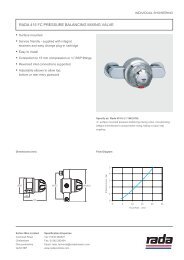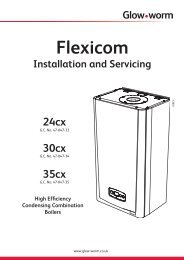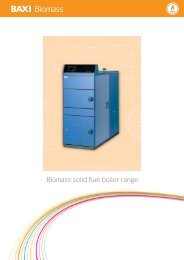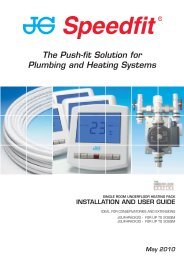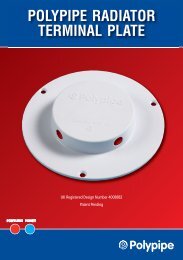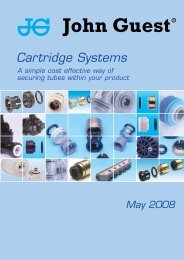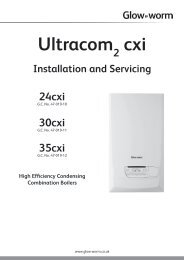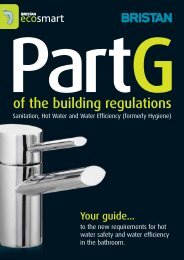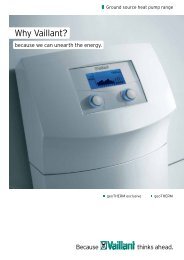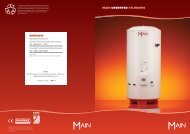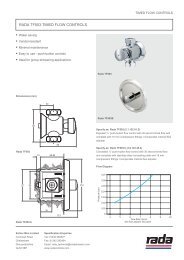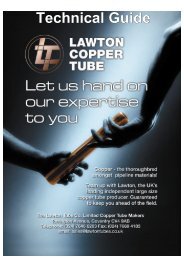Hep20 Technical Handbook
Hep20 Technical Handbook
Hep20 Technical Handbook
You also want an ePaper? Increase the reach of your titles
YUMPU automatically turns print PDFs into web optimized ePapers that Google loves.
Connection to Boilers and<br />
Heaters<br />
Where boilers incorporate a high<br />
limit cut out thermostat, pump<br />
overrun device, and have<br />
connections outside the boiler<br />
casing 350mm from the heat source,<br />
direct connection can be made to<br />
Hep 2 O ® . Typically these boilers<br />
contain a copper heat exchanger<br />
and are low water content boilers.<br />
See Figure 8.<br />
Where any one of the above<br />
criteria for direct connection to a<br />
boiler cannot be met a minimum<br />
one metre run of copper pipe<br />
should be installed between the<br />
boiler and the start of the Hep 2 O ®<br />
system. See Figure 9.<br />
In all cases (including instantaneous<br />
water heaters, caravan heaters etc.)<br />
care should be taken to ensure that<br />
appliances have the appropriate<br />
thermostatic controls and cut outs<br />
to ensure that operating conditions<br />
do not exceed the temperature and<br />
pressure limits laid down for Class S<br />
pipe (see Table 2, page 41). For any<br />
type of back boiler all water<br />
connections should be extended<br />
from the appliance to the outside of<br />
the fireplace opening in copper<br />
tube.<br />
In these instances, where the heat<br />
output may be uncontrolled, a<br />
minimum one metre run of copper<br />
pipe should be used between the<br />
boiler and the start of the Hep 2 O ®<br />
system.<br />
Any gravity circuit of a solid fuel<br />
boiler should always be installed in<br />
copper.<br />
Regulations require that metal pipe<br />
be used as discharge pipe from<br />
temperature/pressure relief valves<br />
on unvented water heaters, to or<br />
from a tundish or from safety valves<br />
on sealed central heating systems.<br />
On sealed systems where the safety<br />
valve is not provided within the<br />
boiler casing, the pipe between the<br />
safety valve and the boiler should be<br />
in copper.<br />
All boiler connections should be<br />
made in accordance with the<br />
requirements of BS 5955: Part 8.<br />
On heating systems where normal<br />
circulation may be drastically<br />
reduced (eg. thermostatic radiator<br />
valves fitted throughout), then a<br />
bypass should be fitted to the<br />
circulation pipework preferably<br />
controlled by an automatic<br />
differential pressure bypass valve.<br />
During commissioning it is<br />
important to ensure that all trapped<br />
air is purged from the heating<br />
system before the boiler is<br />
operated. ‘Pockets’ of air can affect<br />
proper circulation and impair the<br />
correct operation of boiler<br />
temperature controls that could<br />
cause severe overheating.<br />
350mm minimum<br />
Boiler with:<br />
•<br />
•<br />
•<br />
•<br />
high limit stat.<br />
pump over-run.<br />
connections outside casing.<br />
connections 350mm from heat<br />
source.<br />
Figure 8<br />
Direct connection to Hep 2 O ®<br />
Boiler with:<br />
•<br />
•<br />
1m minimum<br />
uncontrolled temperature<br />
(i.e. solid fuel).<br />
connections within casing<br />
(cast iron heat exchanger).<br />
Figure 9<br />
Connection via copper pipe<br />
51



